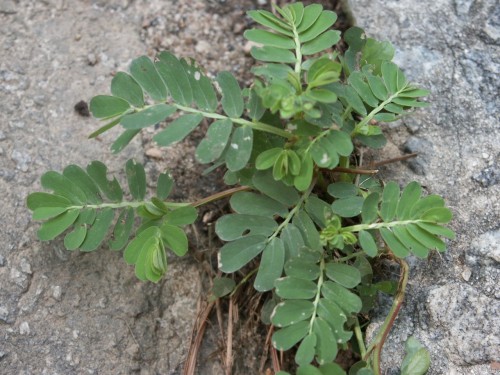





In order to respond to the many garden questions I receive, I’ve assembled a crack team of Master Gardeners to help me. Theresa, Stacy, Caryn and Shannon have myriad different garden skills and interests and I can count on them to know the answer to most of the queries we get via e-mail.
When Stacy e-mailed all of us a panicky personal question a few days ago, I knew it had to be a stumper. “Help! My lawn has been invaded by little mimosa seedlings. I have tried everything to get rid of them but nothing seems to work. Are any of you familiar with this weed?”
Familiar?? Heck, I’m on a first name basis with this pest. My neighbor Gus brought it to my attention a few years ago in his lawn. Now he spends a half-hour each week pulling it from his flower beds and his fescue.
The weed has a tongue-twisting name: niruri (Phyllanthus urinaria). In later years, scientists have started calling it chamberbitter but under either moniker it can be a major nuisance in your landscape. Niruri in Spanish literally means “break stone”. The mature plant is a small shrub which grows widely in South America and Asia. There, it is used as an herbal remedy for kidney stones. In my lawn, constant mowing keeps it three inches tall and looking exactly like a mimosa leaf.
Stacy’s lack of success controlling niruri is duplicated by weed scientists. No herbicide will knock it out quickly and permanently. Dr. Tim Murphy, my Extension service weed guru, says repeated applications of an herbicide that contains 2,4-D (Weed-B-Gon, Weed Stop, Wipe-Out, etc) will control it, particularly if you start spraying when the weed is young.
The yellow, ball-like seeds of niruri develop under the leaves. They need very warm soil in order to germinate so you won’t notice the seedlings until mid-summer. Researchers say pre-emergence herbicides that contain atrazine (Purge) on centipede lawns and isoxaben (click for sources) on all turfgrasses give good results when applied in early May.
Like my neighbor, you may find that simply pulling out the weed gives good enough results. Be sure to discard the plants immediately; don’t put them on your compost pile. Whatever you choose to do, though, don’t let this tongue-twisting pest become well-established unless you enjoy back-breaking labor!
Q: I looked up the mimosa-like weed that was mentioned in your recent column and found it to be chamberbitter. It is all in my lawn and flower beds. Now that I know what it is, how do I kill it?
A: Chamberbitter (Phyllanthus urinaria) is a tropical weed that has become a major pest of lawns, landscapes and plant nurseries. Glyphosate (Roundup) will kill it but you have to be careful to keep the chemical off nearby foliage. In a lawn, broadleaf weedkiller (Weed-B-Gon, Weed Stop, etc.) applied twice, seven days apart, is also effective.
The best way to control the weed is to prevent it. Apply isoxaben pre-emergent herbicide in late April and again in mid-June to areas where you will not be planting seeds for anything else. As with every herbicide, read the label and follow it exactly.
See also Phyllanthus A Growing Problem in Georgia Landscapes

chamberbitter
Copyright © www.100flowers.win Botanic Garden All Rights Reserved